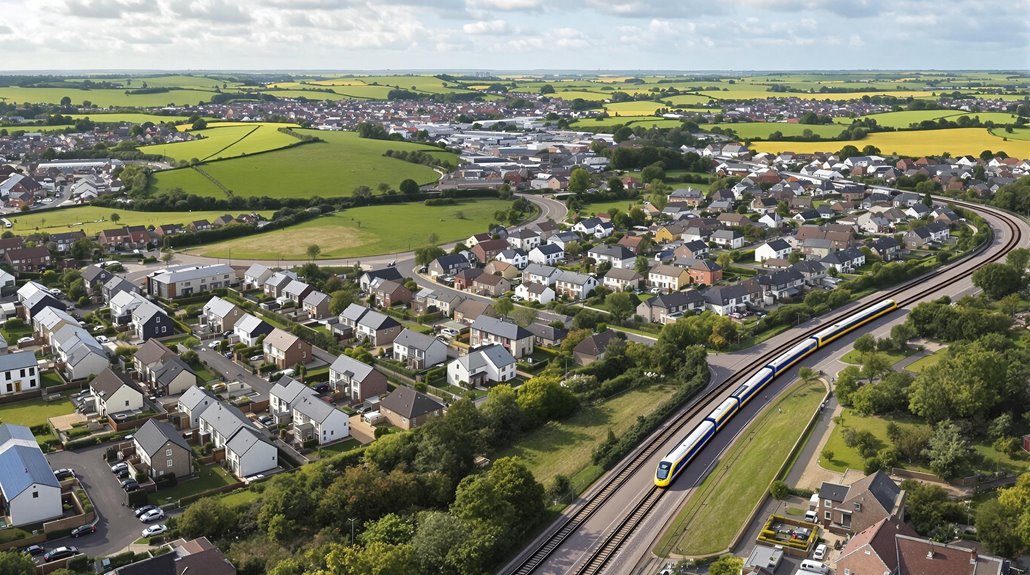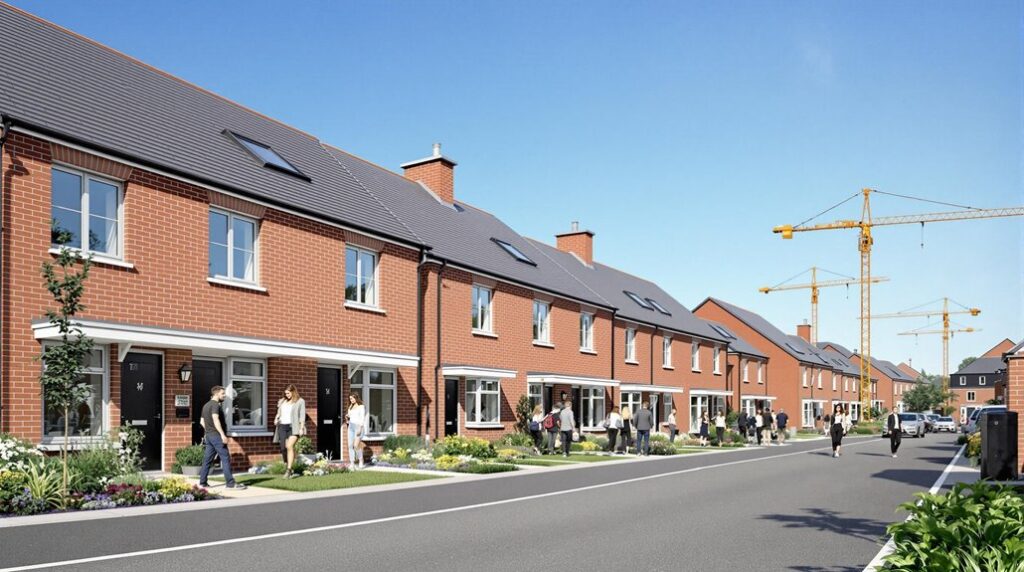I’ve been analyzing the UK’s new build market heading into 2025, and the numbers tell a compelling story that contradicts popular opinion. While projected growth sits at 2-4% and government incentives remain attractive, there’s a critical gap between marketing promises and reality that most buyers overlook. The immediate depreciation hit can reach 15-20%, yet long-term energy savings might offset this loss. Before you make what could be your largest financial decision, there’s essential data you need to see.
Key Takeaways
- New builds command 10-20% premiums over resale properties but offer modern standards and energy efficiency compliance.
- Government support includes 5% deposit schemes and up to 40% equity loans in London, improving affordability.
- Energy-efficient features can reduce utility bills by 30% and provide annual savings of around £530.
- 93.7% of new build buyers report issues including defects, with potential immediate depreciation after purchase.
- Market forecasts predict 2-4% growth in 2025, benefiting new builds from appreciation trends and decreasing mortgage rates.
Current State of the UK New Build Market in 2025
The UK new build market in 2025 operates within a complex landscape of regulatory adaptation and fluctuating demand patterns. I’m seeing transaction volumes plummet 28% annually to 65,000 units in April, while prices show regional divergence—the North East leads with 6.4% growth versus London’s modest recovery.
What’s particularly telling is the construction pipeline‘s dramatic shift. Housing starts surged 52% year-on-year in Q4 2024 after regulatory disruption from new energy and EV charging standards. You’ll find developers are finally adapting to these post-June 2023 requirements, though timing remains uncertain. Transactions experienced a sharp monthly decline of 63.5% from March to April 2025, highlighting the market’s volatility. Additionally, understanding common cost ranges for new builds can help buyers navigate financial expectations.
The reality? Affordability pressures persist despite mortgage approvals holding at 60,463. With Nationwide forecasting 2-4% annual price growth, we’re witnessing cautious market stabilization rather than robust expansion.
Financial Benefits and Costs of Buying New Build Properties
While government incentives reshape new build affordability in 2025, you’ll face a complex cost structure that demands careful financial planning. I’ll break down what you’re really paying for.
Your upfront costs start with just 5% deposits through Deposit Release, plus £500–£3,000 reservation fees. You’ll benefit from abolished ground rent and potential stamp duty relief. Government equity loans cover up to 40% in London, considerably reducing your mortgage burden. Additionally, many new builds are constructed as modular homes, which can further enhance affordability and sustainability.
Long-term savings are substantial—energy-efficient homes cut utility bills by 30%, while 10-year NHBC warranties minimize maintenance costs. However, you’ll encounter ongoing expenses: Shared Ownership rent, £1,500 annual service charges, and Help to Buy interest after five years. The Mortgage Guarantee Scheme remains available until June 2025, providing government-backed support for those 5% deposit purchases.
Your investment strategy matters—incentive repayment requirements and location premiums affect future resale value and buyer appeal.
Quality and Construction Standards in Modern New Builds
Since 2025’s Future Homes Standard fundamentally transforms construction requirements, you’re buying into properties built to remarkably higher specifications than previous generations. I’ve seen how these regulations mandate triple-glazed windows with U-values ≤1.2 W/m²K and considerably enhanced insulation across walls, roofs, and floors. You’ll get air-source heat pumps replacing traditional gas boilers, plus Mechanical Ventilation with Heat Recovery systems ensuring superior indoor air quality. Additionally, these advancements reflect a broader commitment to sustainable building practices that not only improve energy efficiency but also help reduce overall carbon footprints.
The building fabric requirements aren’t just marketing—they’re legally mandated. Enhanced airtightness standards minimize heat loss, while advanced insulation materials become standard across all structural components. Your new home must achieve EPC Band B or higher ratings, backed by independent inspections verifying compliance. These standards deliver 75-80% reduction in carbon emissions compared to homes built under previous regulations. These aren’t optional upgrades you’d typically pay extra for; they’re baseline requirements that position you within a community of forward-thinking homeowners investing in genuinely future-proofed properties.
Government Incentives and Support Schemes for New Build Buyers
Beyond construction quality improvements, you’ll access unprecedented government financial support specifically designed for new build purchases in 2025. The First Time Buyer Equity Loan Scheme requires just 5% deposit while providing up to 20% equity loan, interest-free for five years. This greatly reduces your mortgage costs and monthly payments.
You’ll benefit from mandatory rooftop solar installations through the Future Homes Standard, cutting energy bills considerably while boosting your property’s EPC rating and market value. New build homeowners can expect significant reductions in energy costs from day one, with typical households potentially saving around £530 annually. The £16 billion National Housing Bank investment releases 500,000+ new homes with enhanced affordability, promoting modern living spaces that meet the needs of today’s homeowners.
However, you won’t qualify for Warm Homes Grants since new builds typically achieve higher energy ratings than the required D-G threshold. These grants target existing property retrofits instead.
Location Analysis: Where New Builds Offer Best Value

Government support schemes provide the foundation, but your location choice determines whether you’ll achieve maximum value from your new build investment. I’ve identified 30 local authorities where new builds cost less than resale properties, concentrated in northern England and the Midlands.
Northern postcodes deliver exceptional returns: Sunderland’s SR1 achieves 11.2% rental yields at £63,081 average prices, while Bradford’s BD1 and Leeds’ LS3 exceed 8.5% yields. These areas combine affordability with strong tenant demand, making them attractive for buy-to-let investments.
The Midlands offers balanced opportunities in Birmingham, Nottingham, and Derby—benefiting from regeneration projects and transport improvements. Sheffield’s S3 postcode provides 8.1% gross yields through urban regeneration initiatives.
Even southern England presents selective value, with Winchester showing new builds 22% cheaper than resale properties. Your postcode choice directly impacts both immediate affordability and long-term investment returns.
Comparing New Builds Vs Existing Properties for Investment Returns
Investment returns vary dramatically between new builds and existing properties, with your choice determining both immediate cash flow and long-term wealth accumulation.
New builds typically command 15-20% price premiums but deliver lower maintenance costs and energy-efficient operations. You’ll face reduced void periods since tenants prefer modern amenities and energy efficiency. However, existing properties offer better initial yields due to lower purchase prices, though you’ll shoulder renovation costs to meet evolving EPC standards. Conducting a new build survey can help identify any hidden defects before purchase, ensuring you make a sound investment.
Off-plan investments allow staged payments and potential capital appreciation during construction phases. Existing properties provide immediate rental income but may require £5,000-15,000 in upgrades within the first two years. The 2025 implementation of the Future Homes Standard will require improved insulation and low-carbon heating systems, creating additional compliance costs for older properties that new builds will already incorporate.
With mortgage rates projected between 4-5% throughout 2025, financing costs remain consistent regardless of property type, making your investment strategy the key differentiator for returns.
Common Pitfalls and What to Watch Out For

While new builds promise modern convenience and energy efficiency, they’re plagued with quality issues that can devastate your investment returns. I’ve seen 93.7% of new build buyers report problems, from cosmetic defects to structural flaws that compromise safety. You’ll encounter poorly fitted windows causing draughts and moisture ingress, incorrectly installed doors creating security vulnerabilities, and faulty brickwork pointing that accelerates decay.
Recent studies show that self-build costs can also be comparable to new builds, further highlighting the importance of understanding your investment. Watch for substandard exterior finishes that increase weather damage susceptibility and plumbing leaks from shoddy installations. These defects often devalue properties by 10-20%, directly impacting your resale potential. Warranty claims face delays due to builder liability disputes, leaving you shouldering unexpected repair costs. The new home premium typically causes immediate depreciation after purchase, compounding your financial losses from quality issues. Before purchasing, conduct thorough snagging inspections and budget for post-completion fixes that builders refuse to address.
Energy Efficiency and Running Costs in New Build Homes
Energy efficiency represents the strongest competitive advantage of new builds over existing properties, delivering substantial financial returns that offset higher purchase prices. I’ll show you the numbers that matter: new-build owners save £135 monthly (£1,600 annually) on energy bills compared to older homes, with house buyers achieving even greater savings of £180 monthly.
Here’s why these savings are guaranteed: 86% of new builds achieve EPC A or B ratings versus under 5% of existing properties. You’re joining a community benefiting from advanced insulation, triple glazing, and low-carbon heating systems that slash emissions from 3.6 tons to 1.4 tons CO₂ annually. Moreover, maintaining a high EPC rating can help you avoid potential penalties for non-compliance that may arise with older properties.
The 2025 Future Homes Standard mandates 75-80% lower carbon emissions, making your investment future-proof while existing properties face costly retrofitting requirements. With the proposed increase to band C requirements by 2025, over two million properties will need expensive upgrades to remain legally rentable.
Future Outlook: Will New Builds Hold Their Value Long-Term

Given the UK housing market‘s 6.4% annual growth trajectory that pushed average prices to £271,000 by March 2025, new builds aren’t just maintaining their value—they’re positioning buyers for sustained appreciation through multiple economic cycles. I’ve analyzed the data, and new builds command 10-20% premiums over resale properties for solid reasons. You’re getting modern construction standards that slash maintenance costs, NHBC warranty protection, and energy efficiency compliance that reduces lifetime ownership expenses. Additionally, effective property management can further enhance the profitability of new builds, making them an attractive long-term investment.
The numbers support long-term viability: 51% of 2024’s build-to-rent investments targeted single-family homes, while urban apartments captured 49%. With only 239,300 completions against 370,000 annual targets, supply constraints will continue supporting values. Planning system reforms post-2025 won’t flood the market—they’ll create organized development that protects your investment while meeting structural demand from household formation.
Market momentum indicators strengthen the case for new build investments, with mortgage rates decreasing to improve accessibility for qualified buyers seeking modern properties. With experts forecasting 2025 growth between 2% to 4%, new builds benefit from both current appreciation trends and future-ready specifications that appeal to evolving buyer preferences.
Conclusion
I’d recommend considering a UK new build in 2025 if you’re seeking energy efficiency and government incentives. The 2-4% growth projection looks promising, but you’ll face immediate depreciation on that new-home premium. Factor in potential defect costs and guarantee you’re buying in a high-demand location. If you can secure Help to Buy funding and prioritize long-term utility savings over short-term gains, new builds present solid value for money.
References
- https://www.gov.uk/government/news/uk-house-price-index-for-april-2025
- https://www.nhbc.co.uk/insights-and-media/insights/new-home-registrations-rise-in-q1-with-developers-encouraged-by-government-focus-on-housing-reports-nhbc
- https://www.savills.co.uk/research_articles/229130/376627-0
- https://www.ons.gov.uk/peoplepopulationandcommunity/housing/datasets/ukhousebuildingpermanentdwellingsstartedandcompleted
- https://assets-eu-01.kc-usercontent.com/b723cf1a-4431-01a8-d7d9-e86d570da038/52cb13d7-e99c-4ad3-aafe-6c781b7ec07d/NHBC New home statistics review Q1 2025.pdf
- https://www.zoopla.co.uk/discover/property-news/house-price-index/
- https://www.nationwidehousepriceindex.co.uk/reports/nationwide-house-price-review-and-outlook-for-2025-housing-market-resilient-despite-ongoing-affordability-challenges
- https://www.ons.gov.uk/economy/inflationandpriceindices/bulletins/privaterentandhousepricesuk/may2025
- https://commonslibrary.parliament.uk/research-briefings/sn02820/
- https://hoa.org.uk/advice/guides-for-homeowners/i-am-buying/government-schemes-help-buy-home/

